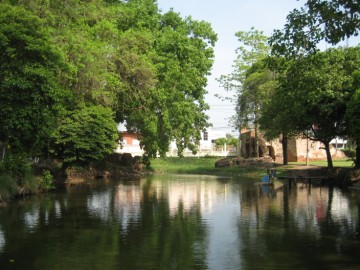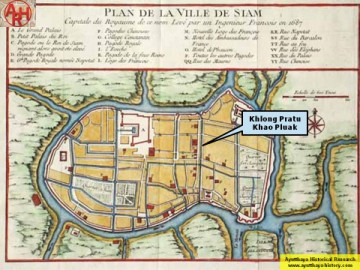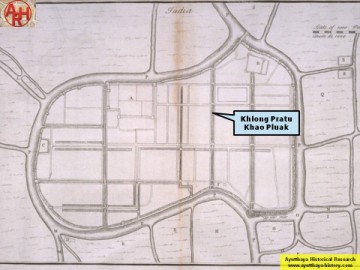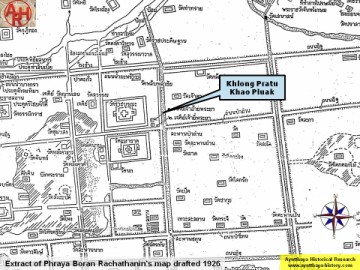
| KHLONG PRATU KHAO PLUAK (คลองประตูข้าวเปลือก) |
| Text, maps & photographs by Tricky Vandenberg - May 2012 |
| Khlong Pratu Khao Pluak or the Canal of the Gate of Unmilled Rice is part of a waterway running through the middle of Ayutthaya from north to south. The canal ran until the Chikun Bridge and continued to the Chinese water gate (Pratu Jin) under the denomination Khlong Pratu Jin. The canal was in fact a shortcut (khlong lat) through the oxbow of the Lopburi River and connected the old Lopburi River, present Khlong Mueang in the north with - what is today - the Chao Phraya River in the south. Khlong Pratu Khao Pluak had its origin at Pratu Khao Pluak or the "Gate of the Unhusked Rice", one of the eleven water gates a that time; and ended up at Pratu Jin or the "Chinese Gate", also a water gate. The canal lies in the present Pratu Chai district of Ayutthaya. The Pratu Ho Ratana Chai canal split off from Khlong Pratu Khao Pluak somewhere near Wat Phlabphla Chai and ran towards Khlong Nai Kai; and to Pratu Ho Ratana Chai were it joined Khlong Khue Na (Front city canal). The waterway had a junction with Bueng Phra Ram, which permitted boats to access the swamp and other canals to the west. The north-south canal was filled in last century and is at present inexistent, with the exception of a small stretch of water between Wat Tha Sai and Wat Racha Praditsathan near Pratu Khao Pluak. The latter was in fact at the same time a water gate and a fortress (Pom Khao Pluak). Traces of the fortress and the water gate (Pratu Khao Pluak) can still be seen in situ. The canal was crossed by four bridges, being Saphan Chang, Saphan Pa Than, Saphan Lat and Saphan Chikun. Khlong Pratu Khao Pluak and its extension Khlong Pratu Jin formed likely until the mid-15th century the eastern defense moat of the city. (1) Khlong Pratu Khao Pluak is mentioned in the Royal Chronicles of Ayutthaya as being a battle front line in 1733. A conflict over the throne succession arose when King Thai Sa (r.1709-1733) appointed his young son Prince Aphai as the next throne ascendant, but the uparat (viceroy), the king's younger brother Prince Phon, residing at the Front Palace, disagreed with the choice. Defenses were readied on both sides. The king's side established stockades along the western bank of the canal down from Pratu Khao Pluak until Pratu Jin. Khun Si Khong Yot was ordered to establish and defend a stockade beside the Bridge of the Elephants. The same occurred on the uparat's side, establishing stockades on the east bank. Si Khong Yot was shot dead in his stockade by gun fire from a house on the edge of the canal during an inspection by the son of the uparat. During this conflict, King Tha Sai, being sick, died at the age of 54. Meanwhile, Celestial Lord Aphai, after His Holy Father had given Him His permission, thereupon accepted the royal wealth. Desiring to engage in war together with the Holy Grand Deputy King, He thereupon commanded the servants in the royal service of the Crown Palace Enclosure to prepare their people and to conscript them to undertake the establishment of stockades and moats. They watched and made inspection trips of the stockades at scattered intervals on down along the Canal of the Gate of Unmilled Rice all the way to the Gate of the Chinese. He thereupon sent Khun Si Khong Yot to establish a stockade beside the Bridge of the Elephants on the western banks of the Canal of the Gate of Unmilled Rice, and had him stay and defend the stockade in that place. [1] The armed engagement was already ongoing for a while when Prince Aphai sent Luang Chaibun, the deputy ruler of Phitsanulok, to attack the Front Palace by an outflanking movement over Chikun. The opposite side reacted immediately, resisted and routed Chaibun's troops. The Phra of Thonburi joined up with Prince Aphai, sent 500 troops over the canal at the Bridge of the Elephants and took two or three stockades on the other side. Troops under Khun Chamnan Borirak (2) counter attacked with a force of three hundred man and succeeded in driving out the troops of the Phra of Thonburi, who was killed on the battlefield. Chamnan's troops continued and attacked the Grand Palace. Prince Aphai and another prince fled by throne barge in direction of Pa Mok where they went in hiding. After more of a week they were discovered and brought before the uparat, who after having them jailed and interrogated for a few days, got them killed following the royal tradition. Afterwards Prince Phon ascended the throne of Ayutthaya as King Borommakot (r.1733-1758). On the east bank of Khlong Pratu Khao Pluak were following temples situated: Wat Tha Sai, Wat Jao Ta, Wat Saphan Than, Wat Lat, Wat Pet and a Brahmin shrine. On the west bank stood Wat Racha Praditsathan, Wat Phlabphla Chai, Wat Racha Burana, Wat Maha That and Wat Jan. Footnotes: (1) Chao Ai and Chao Yi fought their battle on elephant near the Pa Than Bridge in front of the city in 1424. The city expanded further east until Khlong Nai Kai (Khlong Makham Riang) in the mid-16th century and towards Khlong Khue Na thereafter. See Ayutthaya's city walls. (2) Chaophraya Chamnan Borirak was a descendant of an Indian Brahmin family established in Ayutthaya in the time of King Prasat Thong. He became the most powerful courtier-official of King Borommakot's reign being the Phra Khlang. He died in 1753 and was succeeded by his son-in-law. [2] References: [1] The Royal Chronicles of Ayutthaya - Richard D. Cushman (2006) - page 415-7 / Source: British Museum, Reverend Phonnarat & Royal Autograph - King Designates Prince Aphai to Succeed Him. [2] In the King's Trail - Remco Raben and Dhiravat Na Pombejra (1997) - page 38. |

| (Last stretch remaining of Khlong Pratu Khao Pluak on the premises of Wat Racha Praditsathan) |

| (Pratu Khao Pluak canal on Bellin's map - 1750) |

| (Pratu Khao Pluak canal on Kaempfer's map - 1690) |

| (Detail of Phraya Boran Rachathanin's map - Anno 1926) |